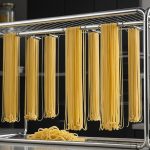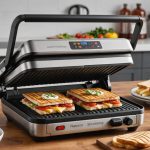Japanese knives are prized worldwide for their exceptional sharpness, precision, and beauty. However, preserving these qualities requires regular maintenance, including sharpening. For this task, ceramic knife sharpeners are often the go-to tool for many chefs and culinary enthusiasts. But with various types of ceramic sharpeners on the market, it can be challenging to decide which one is best suited for Japanese knives.
This article will provide a comprehensive guide to distinct types of ceramic knife sharpeners and their suitability for Japanese knives. We will delve into pull-through sharpeners, honing rods, sharpening stones, and bench stones. By the end, you’ll have a clear understanding of which type is best for your prized Japanese knives.
Additional reading : Must-have food processor accessories for effortless cooking
Pull-Through Sharpeners
Pull-through ceramic knife sharpeners are a popular choice among beginners due to their simplicity and convenience. They have a V-shaped slot into which you pull the knife back and forth to sharpen the blade. Some of these sharpeners even offer multiple slots for different levels of sharpness.
Pull-through sharpeners can be an excellent choice for those just starting with knife maintenance. However, they might not always be the best option for Japanese knives. These tools are often designed to accommodate a wide variety of knife types and may not be optimized for the unique angle and delicate blade of a traditional Japanese knife. They can also remove more material than necessary, leading to premature wear of your knife.
Additional reading : Which Features Make a Kitchen Timer Visually Accessible for the Visually Impaired?
If you decide to use a pull-through sharpener, look for one specifically designed for Japanese knives. These models will ensure your knife maintains the correct angle and sharpness level while minimizing damage to the blade.
Honing Rods
Honing, contrary to popular belief, is not the same as sharpening. A honing rod realigns the blade’s edge without removing significant material, extending the time between sharpenings. Ceramic honing rods are favored for their fine grit and hard surface, which can handle the hardness of Japanese knife steel.
Using a honing rod can be a bit tricky due to the hand-eye coordination required to maintain the proper angle. But once you get the hang of it, it’s a quick and effective way to keep your Japanese knives in top shape.
While honing rods are a valuable tool in knife maintenance, they do not replace the need for a good sharpener. They are best used in conjunction with a sharpening stone or bench stone, which we will discuss next.
Sharpening Stones
Sharpening stones, or whetstones, are arguably the best tool for sharpening Japanese knives. They offer the most control over the sharpening process and are capable of restoring even the most dulled blades.
Sharpening stones come in various grit levels, from coarse (used for initial sharpening) to ultra-fine (for finishing touches). For Japanese knives, which typically have a very thin edge, a medium to fine grit stone is generally recommended.
The main drawback of sharpening stones is that they require some skill to use effectively. Maintaining the correct angle and applying even pressure are crucial for a consistent edge. However, with a little practice, you can achieve professional-level results at home.
Bench Stones
Bench stones are another variety of sharpening stone that deserves mention. They are larger and thicker than standard sharpening stones, providing a stable, flat surface for sharpening your knives. The wider surface area allows for more extensive blade contact, leading to faster sharpening.
Like standard sharpening stones, bench stones come in various grit levels. For Japanese knives, select one with a medium to fine grit to avoid damaging the blade.
While bench stones offer excellent performance, their larger size can make them less convenient to store and use, particularly in smaller kitchens. They also require a similar level of skill and practice to use effectively as standard sharpening stones.
As you’ve learned, not all ceramic knife sharpeners are equal when it comes to Japanese knives. Each type has its pros and cons, and the best choice depends on your skill level, convenience, and the specific needs of your knives. While pull-through sharpeners and honing rods offer simplicity and ease of use, sharpening stones and bench stones provide the most control and precision, making them the preferred choice of many professionals and knife enthusiasts.
Comparing Sharpening Tools: Which One to Choose?
Having explored the various types of ceramic knife sharpeners—pull-through sharpeners, honing rods, sharpening stones, and bench stones—it’s apparent that each tool has its strengths and specific role in maintaining the sharpness of Japanese knives. The ultimate choice depends on your personal needs, skill level, and the specific requirements of your knives.
Pull-through sharpeners, while easy to use, may not be the best choice for traditional Japanese knives due to their potential to cause unnecessary blade wear. This tool is better suited for beginners or those with a wide variety of knife types. Remember, if you opt for this type, ensure it’s specifically designed for Japanese knives to maintain the correct angle and sharpness.
Honing rods are excellent for realigning the edge of your knife without removing significant material. This extends the lifespan of your blade, preserving its sharpness for longer periods. However, honing is not a substitute for sharpening, as it does not remove material to create a new edge. Hence, this tool is best used in conjunction with a sharpening stone or bench stone.
Sharpening stones or whetstones provide the most control over the sharpening process. With a little practice, you can successfully restore even the most dulled blades. For Japanese knives, a medium to fine grit stone is recommended. Despite the skill level required, the precision and control offered by sharpening stones make them a favorite among professionals.
Bench stones, similar to standard sharpening stones, offer an extensive surface area for faster sharpening. While they require similar skill levels as sharpening stones, their larger size may pose a storage inconvenience, especially in small kitchens.
Conclusion
Japanese knives, renowned for their sharpness and precision, require regular maintenance to preserve their quality. While there are many types of ceramic knife sharpeners available, not all are suitable for this specific type of knife. Your choice of a sharpener should consider the qualities and needs of your Japanese knife, your skill level, and your personal convenience.
Remember, pull-through sharpeners offer simplicity and ease of use for beginners, but they may not be the best for Japanese knives. Honing rods are great for realigning the edge of your knife, extending the time between sharpenings. Sharpening stones and bench stones provide the most control and precision, making them the top choice for many professionals and knife enthusiasts.
Regardless of your choice, regular maintenance is key to preserving the quality of your Japanese knives. With the right tools and techniques, your knives will stay sharp and efficient, helping you make precise cuts and elevating your culinary skills.











